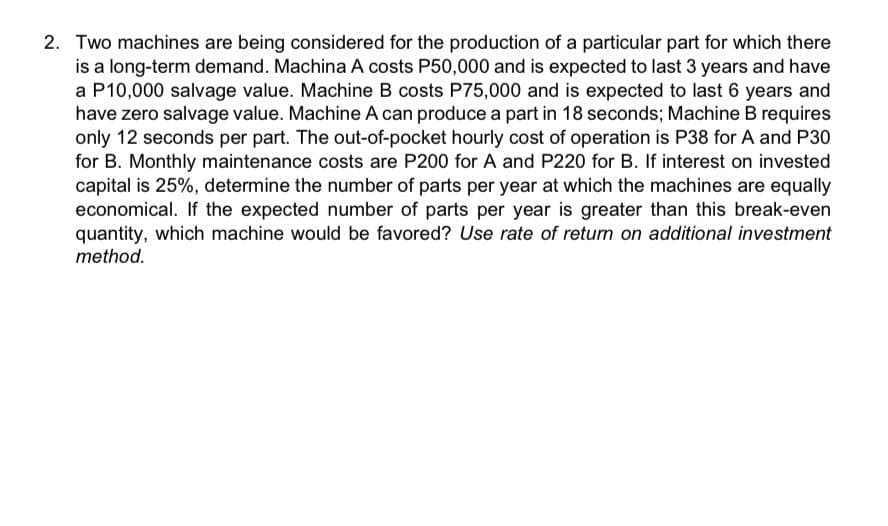Two machines are being considered for the production of a particular part for which there is a long-term demand. Machina A costs P50,000 and is expected to last 3 years and have a P10,000 salvage value. Machine B costs P75,000 and is expected to last 6 years and have zero salvage value. Machine A can produce a part in 18 seconds; Machine B requires only 12 seconds per part. The out-of-pocket hourly cost of operation is P38 for A and P30 for B. Monthly maintenance costs are P200 for A and P220 for B. If interest on invested capital is 25%, determine the number of parts per year at which the machines are equally economical. If the expected number of parts per year is greater than this break-even quantity, which machine would be favored? Use rate of return on additional investment method.
Two machines are being considered for the production of a particular part for which there is a long-term demand. Machina A costs P50,000 and is expected to last 3 years and have a P10,000 salvage value. Machine B costs P75,000 and is expected to last 6 years and have zero salvage value. Machine A can produce a part in 18 seconds; Machine B requires only 12 seconds per part. The out-of-pocket hourly cost of operation is P38 for A and P30 for B. Monthly maintenance costs are P200 for A and P220 for B. If interest on invested capital is 25%, determine the number of parts per year at which the machines are equally economical. If the expected number of parts per year is greater than this break-even quantity, which machine would be favored? Use rate of return on additional investment method.
Managerial Economics: Applications, Strategies and Tactics (MindTap Course List)
14th Edition
ISBN:9781305506381
Author:James R. McGuigan, R. Charles Moyer, Frederick H.deB. Harris
Publisher:James R. McGuigan, R. Charles Moyer, Frederick H.deB. Harris
Chapter1: Introduction And Goals Of The Firm
Section: Chapter Questions
Problem 4E: In the Southern Company Managerial Challenge, which alternative for complying with the Clean Air Act...
Related questions
Question

Transcribed Image Text:2. Two machines are being considered for the production of a particular part for which there
is a long-term demand. Machina A costs P50,000 and is expected to last 3 years and have
a P10,000 salvage value. Machine B costs P75,000 and is expected to last 6 years and
have zero salvage value. Machine A can produce a part in 18 seconds; Machine B requires
only 12 seconds per part. The out-of-pocket hourly cost of operation is P38 for A and P30
for B. Monthly maintenance costs are P200 for A and P220 for B. If interest on invested
capital is 25%, determine the number of parts per year at which the machines are equally
economical. If the expected number of parts per year is greater than this break-even
quantity, which machine would be favored? Use rate of return on additional investment
method.
Expert Solution
This question has been solved!
Explore an expertly crafted, step-by-step solution for a thorough understanding of key concepts.
Step by step
Solved in 4 steps

Knowledge Booster
Learn more about
Need a deep-dive on the concept behind this application? Look no further. Learn more about this topic, economics and related others by exploring similar questions and additional content below.Recommended textbooks for you

Managerial Economics: Applications, Strategies an…
Economics
ISBN:
9781305506381
Author:
James R. McGuigan, R. Charles Moyer, Frederick H.deB. Harris
Publisher:
Cengage Learning

Managerial Economics: Applications, Strategies an…
Economics
ISBN:
9781305506381
Author:
James R. McGuigan, R. Charles Moyer, Frederick H.deB. Harris
Publisher:
Cengage Learning